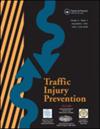选择从酒类供应场所(ASEs)驾车离开。
IF 1.6
3区 工程技术
Q3 PUBLIC, ENVIRONMENTAL & OCCUPATIONAL HEALTH
引用次数: 0
摘要
目的:在酒精或药物影响下驾驶(DUI)的发生率已成为世界范围内发生严重道路交通事故的一个突出因素。酒后驾驶通常发生在光顾酒精服务场所(ASE)并可能饮酒之后,因此作为酒后驾驶事件的一个可能来源而备受关注:方法:我们将统计和机器学习模型应用于维多利亚州旅行和活动综合调查(VISTA),以确定导致澳大利亚维多利亚州酒类供应场所驾车出行的因素:结果:我们的研究结果表明,约有 10% 的人在前往 ASE 时是汽车乘客,而在离开 ASE 后转为驾车出行。我们还发现,旅行距离短于 1 公里、活动时间在 3 至 4 小时之间会对在 ASE 旅行中从汽车驾驶向其他交通方式的转换产生积极影响。进一步的研究结果表明,午夜过后驾车出行的比例下降,而使用公共交通和出租车的比例上升。在长距离的自用和替代能源出行中,人们更倾向于开车,而在短距离的自用和替代能源出行中则更倾向于步行。回家也会增加驾车出行的可能性,而参加其他社交活动则不会。在日托中心逗留时间较长和车辆过夜会降低驾驶倾向,这可能是由于在这些时间内饮酒量增加所致:这些发现表明,行为调整可减轻酒后驾车。具体来说,人们可以在短途旅行时步行,而在较长的日托中心旅行时使用公共交通工具或出租车。本文章由计算机程序翻译,如有差异,请以英文原文为准。
Choosing to drive from alcohol serving establishments (ASEs)
Objective
The prevalence of Driving Under the Influence (DUI) of alcohol or drugs has become a prominent factor in the occurrence of severe road crashes worldwide. Driving often occurs after visiting, and presumably drinking, at Alcohol-Serving Establishments (ASEs), and is thus of interest as a possible source of DUI events.
Methods
We apply statistical and machine learning models to the Victorian Integrated Survey of Travel and Activity (VISTA) to identify factors that contribute to driving in trips from ASEs in Australia’s state of Victoria.
Results
Our results highlight that approximately 10% of individuals who traveled to ASEs as car passengers switched to driving after leaving there. It was also observed that travel distance shorter than 1 km and activity duration between 3 and 4 h positively impacts the mode switching from car driver to other modes in ASEs trips. Further findings illustrate a decline in driving after midnight, with an increase in the use of public transport and taxis. Individuals prefer driving for long-distance ASEs trips and walking for short distances. Going home also increased the likelihood of driving, whereas engaging in other social activities did not. Longer stays at ASEs and leaving vehicles overnight reduce the propensity to drive, likely due to increased alcohol consumption during these times.
Conclusions
These findings suggest behavioral adjustments that can mitigate driving under the influence. Specifically, people may walk for short-distance trips and use public transport or taxis for longer ASEs trips.
求助全文
通过发布文献求助,成功后即可免费获取论文全文。
去求助
来源期刊

Traffic Injury Prevention
PUBLIC, ENVIRONMENTAL & OCCUPATIONAL HEALTH-
CiteScore
3.60
自引率
10.00%
发文量
137
审稿时长
3 months
期刊介绍:
The purpose of Traffic Injury Prevention is to bridge the disciplines of medicine, engineering, public health and traffic safety in order to foster the science of traffic injury prevention. The archival journal focuses on research, interventions and evaluations within the areas of traffic safety, crash causation, injury prevention and treatment.
General topics within the journal''s scope are driver behavior, road infrastructure, emerging crash avoidance technologies, crash and injury epidemiology, alcohol and drugs, impact injury biomechanics, vehicle crashworthiness, occupant restraints, pedestrian safety, evaluation of interventions, economic consequences and emergency and clinical care with specific application to traffic injury prevention. The journal includes full length papers, review articles, case studies, brief technical notes and commentaries.
 求助内容:
求助内容: 应助结果提醒方式:
应助结果提醒方式:


